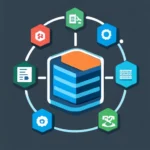Introduction
When it comes to cloud data engineering, there are two main methods for moving and processing data: ETL (Extract, Transform, Load) and ELT (Extract, Load, Transform). Both of these approaches have their own pros and cons, making it difficult to determine which one is the better option. In this ultimate faceoff of ETL vs ELT, we will dive into the key differences between these methods and explore the benefits and drawbacks of each. By the end, you’ll have a better understanding of which method is best suited for your specific data needs in the cloud.
Background on data engineering and the importance of ETL/ELT

Data engineering is a crucial aspect of modern-day business operations. It involves collecting, organizing, and processing large volumes of data to extract meaningful insights. This data is often scattered across various sources, making it challenging to analyze and utilize effectively.
In this context, ETL (Extract, Transform, Load) and ELT (Extract, Load, Transform) play a pivotal role. ETL involves extracting data from multiple sources, transforming it into a unified format, and then loading it into a target destination such as a data warehouse. On the other hand, ELT involves extracting data and loading it into a target destination without immediate transformation. The transformation occurs after the data is loaded, using powerful processing capabilities in the target environment.

Definitions of ETL and ELT
ETL (Extract, Transform, Load) and ELT (Extract, Load, Transform) are two common methods used in cloud data engineering. Let’s dive into their definitions to better understand these approaches.
ETL stands for Extract, Transform, Load. In ETL, data is first extracted from various sources, such as databases, applications, or APIs. Once extracted, the data is then transformed into a unified format, where any necessary cleaning, normalization, or aggregation takes place. Finally, the transformed data is loaded into a target destination, often a data warehouse or a data lake, for further analysis and processing.
On the other hand, ELT stands for Extract, Load, Transform. As the name suggests, in ELT, data is first extracted from multiple sources and loaded directly into the target destination without immediate transformation. The transformation step occurs after the data is loaded, leveraging the powerful processing capabilities of the target environment. This approach allows for flexible and scalable transformations, as well as the ability to handle large volumes of raw data.
In summary, ETL focuses on transforming data before loading it into the target destination, while ELT emphasizes loading the data first and performing transformations later. The choice between ETL and ELT depends on various factors, which we will explore in detail in the following sections.
Pros and Cons of ETL

ETL (Extract, Transform, Load) is a widely used method in cloud data engineering, and it comes with its own set of advantages and disadvantages. Let’s take a closer look at the pros and cons of ETL.
One of the key benefits of ETL is its ability to transform data before loading it into the target destination. This allows for data cleaning, normalization, and aggregation, ensuring that the data is in a unified format for further analysis. Additionally, ETL provides a structured and controlled environment for data processing, which can be advantageous for organizations with strict data governance policies.
However, ETL also has some drawbacks. One of the main challenges is the potentially longer processing time, as the transformation step occurs before data loading. This can be a bottleneck when dealing with large volumes of data, resulting in slower data pipelines. Furthermore, ETL requires a predefined schema and data model, which can limit flexibility and make it difficult to accommodate changes in data sources or transformations.
Overall, ETL is a powerful method for data engineering, offering data cleaning and structuring capabilities. However, its limitations in terms of processing time and flexibility should be carefully considered before choosing it as the preferred method for cloud data engineering.

Pros and Cons of ELT
ELT (Extract Load Transform) is another popular method in cloud data engineering, and it offers its own unique set of advantages and disadvantages. Let’s delve into the pros and cons of ELT.
One of the major benefits of ELT is its ability to load data directly into the target destination without immediate transformation. This allows for faster data ingestion, especially when dealing with large volumes of raw data. Additionally, ELT provides a more flexible approach to data processing, as transformations are performed after the data is loaded. This flexibility enables organizations to adapt to changing data sources and accommodate new transformations as needed.
However, ELT also has its drawbacks. Since transformations are performed after the data is loaded, it may require more powerful processing capabilities in the target environment. This can lead to increased infrastructure costs and resource requirements. Moreover, ELT relies heavily on the target environment’s processing capabilities, which means that the performance of data transformations is dependent on the capabilities of the chosen data platform.

Which method is preferred in cloud data engineering?
Now that we have explored the differences, pros, and cons of ETL and ELT, the question remains: which method is preferred in cloud data engineering? Well, the answer isn’t as simple as choosing one over the other. The preference between ETL and ELT depends on various factors, including the specific needs and priorities of your data engineering project.
If data cleaning and structuring are of utmost importance, ETL may be the preferred method for you. The ability to transform data before loading it into the target destination allows for a controlled and structured environment for data processing. However, if speed and flexibility are your top priorities, ELT may be the way to go. With its faster data ingestion and more adaptable approach to transformations, ELT offers greater flexibility and scalability.
Factors to consider when choosing between ETL and ELT

When choosing between ETL and ELT for your cloud data engineering project, there are several important factors to consider. One of the key factors is the nature of your data and its transformation requirements. If your data requires extensive cleaning, normalization, or aggregation before loading it into the target destination, ETL (Extract, Transform, Load) may be the better choice. ETL allows for a structured and controlled environment for data processing, ensuring that the data is in a unified format for further analysis.
On the other hand, if speed and flexibility are your priorities, ELT (Extract, Load, Transform) may be the preferred method. ELT allows for faster data ingestion, as it skips the immediate transformation step and loads the data directly into the target destination. This flexibility can be advantageous when dealing with large volumes of raw data or when the data sources or transformation requirements are subject to frequent changes.
Another factor to consider is the scalability of your data engineering solution. ETL may have limitations in terms of processing time, especially when dealing with large volumes of data. ELT, on the other hand, leverages the powerful processing capabilities of the target environment, making it more scalable and capable of handling increasing data volumes.
Additionally, consider the infrastructure and resource requirements of each method. ETL may require a predefined schema and data model, which can limit flexibility and make it difficult to accommodate changes in data sources or transformations. ELT, on the other hand, relies heavily on the processing capabilities of the target environment, which can result in increased infrastructure costs and resource requirements.
Ultimately, the choice between ETL and ELT depends on the specific needs and priorities of your data engineering project. Assess the nature of your data, evaluate the speed, flexibility, scalability, and resource requirements of each method, and choose the one that aligns best with your goals and resources.
Best practices for ETL and ELT in cloud data engineering
When it comes to ETL (Extract, Transform, Load) and ELT (Extract, Load, Transform) in cloud data engineering, there are several best practices that can help ensure successful implementation.
First and foremost, it is crucial to have a clear understanding of your data and its transformation requirements. Before starting the ETL or ELT process, thoroughly analyze your data sources, identify any potential inconsistencies or anomalies, and determine the necessary transformations. This will help you streamline the process and avoid any unnecessary complications or errors.
Additionally, it is essential to establish a robust data governance framework. Implement proper data quality checks and validations at each step of the ETL or ELT process to ensure the accuracy and integrity of your data. This includes data profiling, data cleansing, and data validation techniques. Regular monitoring and auditing of your data pipeline will help identify any issues or bottlenecks and enable timely resolution.
Another best practice is to prioritize scalability and performance. As your data volume increases, your ETL or ELT process should be able to handle the load efficiently. Consider leveraging cloud-native technologies and distributed computing capabilities to ensure scalability and optimize performance. This may involve using parallel processing, leveraging serverless computing, or implementing auto-scaling mechanisms.
Lastly, documentation and version control are crucial for maintaining the integrity and reproducibility of your ETL or ELT process. Clearly document your data sources, transformation rules, and target destinations. Use version control systems to track any changes made to your data pipelines and ensure proper documentation is in place.
Future trends and developments in ETL/ELT for cloud data engineering
As technology continues to advance, we can expect to see exciting future trends and developments in ETL/ELT for cloud data engineering. One key area of focus will be automation and AI-powered capabilities. Extract Transform Load (ETL) and Extract Load Transform (ELT) processes can be time-consuming and resource-intensive, but with the integration of artificial intelligence and machine learning, we can expect to see more efficient and intelligent data transformation and loading. Automated data mapping, intelligent schema detection, and smart data cleansing algorithms are just a few examples of how automation and AI can revolutionize ETL/ELT processes.
Another trend to watch out for is the increasing adoption of cloud-native technologies and serverless architectures. With the scalability and flexibility offered by cloud platforms, organizations can build robust and agile ETL/ELT pipelines that can handle large volumes of data and accommodate dynamic data sources. Serverless architectures, such as AWS Lambda or Azure Functions, allow for event-driven data processing, enabling real-time and near-real-time ETL/ELT workflows.
Furthermore, we can expect to see advancements in data streaming and real-time analytics capabilities. As businesses strive to make faster and more informed decisions, the demand for real-time data integration and analysis will continue to grow. ETL/ELT processes will need to adapt to handle continuous data streaming and enable real-time transformations and loading.
Please note that the views expressed above are solely my personal opinions and do not reflect the viewpoints of my present or past employers.

